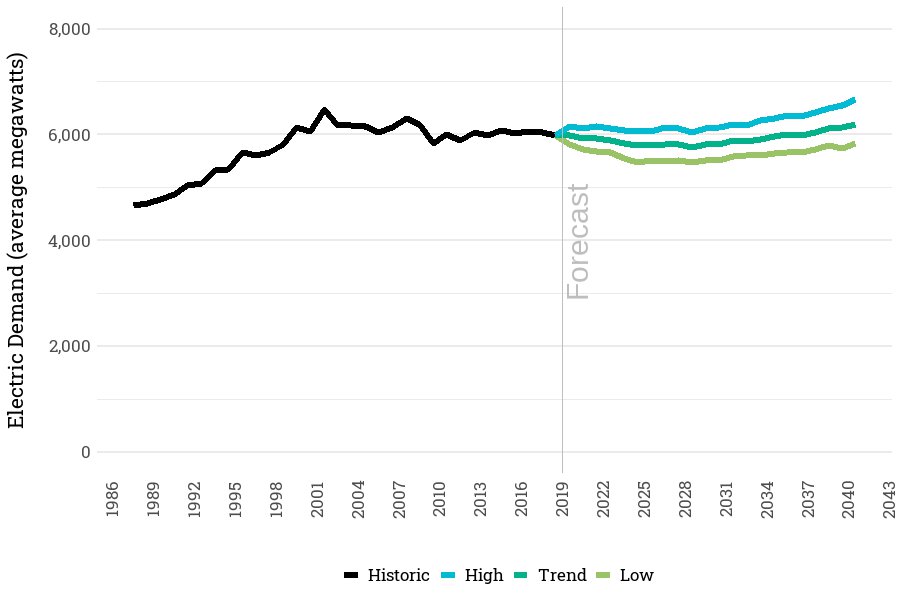The commercial sector load forecast is driven by the need for lighting, air conditioning, and miscellaneous end-uses (e.g., embedded data centers). Commercial sector load is expected to grow from about 6000 in 2018 to a range of about 6800 aMW by 2041. This rate of increase is lower than was forecast in previous Power Plans. Two major factors contribute to slower growth rates. The first is a slowdown in commercial construction activities during the recession, and second is implementation of federal standards and availability of more efficient LED lighting. By 2041, building codes and appliance standards are estimated to lower demand in the commercial sector by about 1200 aMW. More detailed information on the commercial sector load forecast is available here.
End-use Level Forecast of Loads in Commercial Sector - CanESM2 Medium (aMW)
| 2018 | 2041 Low | 2041 Medium | 2041 High | AAGR 2021-2041 | |
| All Commercial | 6,062 | 6080 | 6,339 | 6807 | 0.27% |
| Space Heating | 467 | 492 | 514 | 550 | 0.55% |
| Water Heating | 152 | 157 | 164 | 176 | 0.75% |
| Other Substitutable[1] | 112 | 176 | 184 | 201 | 1.97% |
| Refrigeration | 711 | 581 | 603 | 653 | -0.34% |
| Lighting | 1,404 | 883 | 919 | 984 | -1.57% |
| Air Conditioning | 1,658 | 1787 | 1,862 | 1994 | 0.26% |
| Other Non-Substitutable[2] | 1,558 | 2004 | 2,094 | 2249 | 1.33% |
The presence of new federal standards, fast moving trend toward more efficient lighting and improvements in embedded data centers all contribute to keeping the range of forecasts in the commercial sector rather tight. These improvements not only impact the forecast of loads, but they also impact the conservation potential and conservation targets. Any reduction in load due to standards, or fast-moving baseline efficiency lowers the load forecast. Our estimate of impact of codes and standards shows that by 2041 regional loads would have been higher by about 1200 aMW.
The range of commercial loads is forecasted to vary from about 6000 aMW in near term to about 7359 aMW under the climate change (GCM 1 or CanESM2) scenario.
Forecast Commercial Electricity Loads (average MW)

Embedded Data Center Loads
Embedded data centers are one of the end-uses covered under the non-substitutable loads in the commercial sector. There are a wide variety of data centers in this category. From small closet size data centers housing servers, storage devices, communication and back up devices serving small restaurants, to large room size data centers serving large retail chains.
There is very limited information about the baseline operating characteristics and load in these data centers. They are typically not separately metered, and their energy usage is typically blended with the usage by other end-uses, such as lighting.
The Council commissioned a study to take the available data center survey results from the 2013/2014 Commercial Building Stock Assessment (CBSA), along with other industry data and develop an estimate of current consumption and project the consumption under various technology trajectories.
For the 2021 Power Plan, council staff did not conduct a separate study on demand from embedded data centers. A detailed analysis on this topic is available through Appendix E of the 7th Power Plan.
[1] Substitutable end-uses include misc. appliances that can use multiple fuels, such as cooking, drying.
[2] Non-substitutable end-uses include, electronic equipment, misc. electric appliances that can only use electricity such as embedded data centers in commercial buildings.


